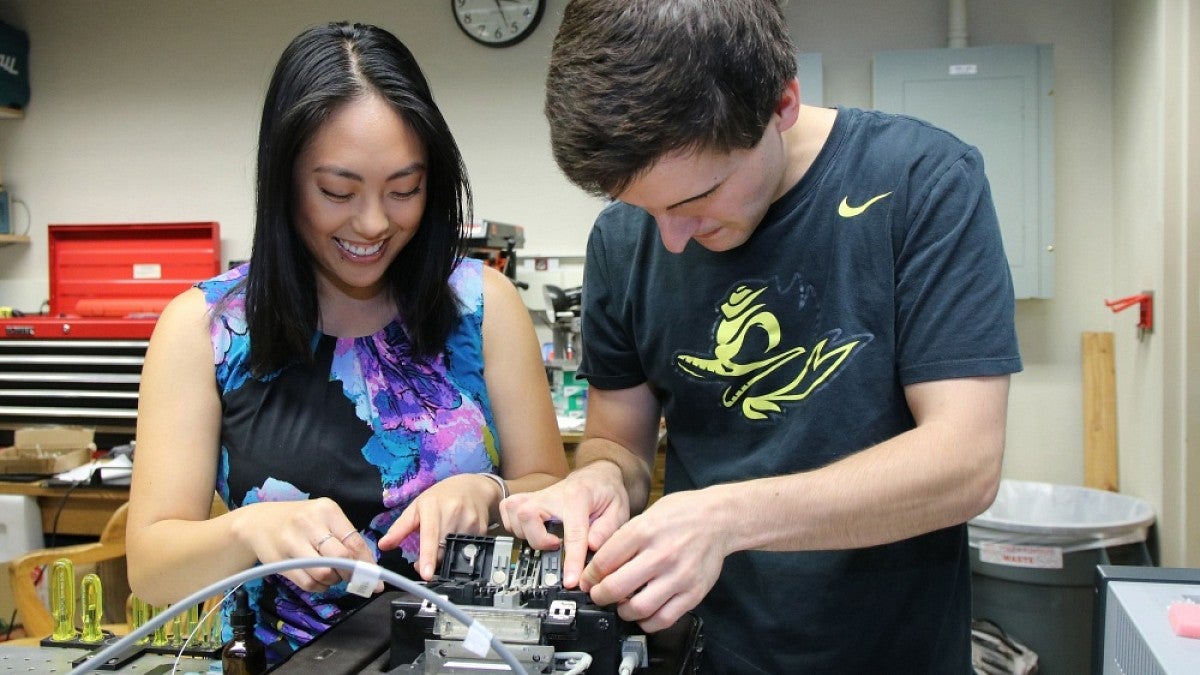The University of Oregon granted more master’s degrees in physics than any other university in the country in 2017, earning a top ranking in a report recently released by the American Institute of Physics.
The majority of the 24 master’s degrees were awarded to students in the Master’s Industrial Internship Program, a long-successful venture boasting more than 600 alumni spanning two decades.
The program, which emerged from a collaboration among the physics and chemistry departments and the Materials Science Institute, was integrated last year into the Phil and Penny Knight Campus for Accelerating Scientific Impact.
As part of the Knight Campus Graduate Internship Program, the master’s program combines a nine-month paid internship with concentrated coursework in four areas: optical materials and devices; photovoltaic and semiconductor device processing; polymer science; and, starting in 2019, molecular sensors.
“Our program’s main focus is to prepare students to excel in an industrial setting and to help launch their careers,” said Nima Dinyari, director of the optics program.
When the first Knight Campus building is complete in 2020, it will host training laboratories and classroom spaces specifically designed for applied graduate education. It will allow students in the program to work closely with scientists and entrepreneurs to help turn discoveries into innovations that improve the quality of life for people in Oregon, the nation and the world.
Over the years, the program’s success has come in large part because of its ability to evolve, based on feedback from top companies and labs across the country.
A prime example of how the curriculum is shaped around industry needs is a Design of Experiments course, which requires use of state-of-the-art software in addition to mastery of principles in statistics and experiment design.
Fuding Lin, who oversees the program’s semiconductor curriculum, created the course to better address the needs of students.
“Our courses allow students to acquire a highly marketable skill set that’s being heavily utilized in the industry,” Lin said. “In fact, many of our students immediately apply what they’ve learned to projects during their internship.”
In addition to summer courses, students complete two electives and a nine-month paid internship in a company or national lab. The average internship salary this year is about $56,000. Many students receive internship offers within a few weeks of completing the summer course work, and a large number of students are later retained as full-time employees upon completion of their internship.
“The program prepares students for working in a real industrial setting,” said Stacey York, director of the master’s program. “Students must learn to solve scientific problems with a general set of constraints — reagents, cost, manufacturing time — without step-by-step instructions. They develop the necessary critical thinking skills and foundational knowledge to do this within their fields.”
In turn, said Bryan Boggs, lecturer of physics, the program adds value to the physics department.
“The MIIP motivates our students to excel in their physics studies and provides a pathway for them to not only obtain an advanced degree but also a rewarding career after graduation,” Boggs said.
Students in the program have a 98 percent graduation rate and a 90 percent employment rate within three months of graduation. Program staff strive to achieve those metrics by putting the time into recruiting and advising students, while also building corporate relationships and developing innovative curriculum. Such commitment from the staff, led by Dinyari, is a major driver of the program’s success, York said.
In the past three years, physics students have interned at 31 unique corporate sites. Students from the 2018 optics and semiconductor programs are interning at large and small organizations across the country, including Aretè Associates, Cree, ESI, HP, Keysight Technologies, Lockheed Martin Corporation, Los Alamos National Lab, Nanohmics, nLight, Ouster, OptoFidelity, Qorvo, Thermo Fisher Scientific, Timbercon and Zemax.
Spencer Mather, a current student in the photovoltaics and semiconductor device processing track, recently began his internship at Thermo Fisher Scientific.
“The UO's curriculum offers a unique blend of understanding fundamental physics, practical knowledge for industry and development of professional skills,” Mather said. “I couldn't imagine a better liaison between academia and industry, and I couldn't picture myself anywhere else."
Kimberly Belmes, a current student in the optical materials and devices track, starts her internship at Lockheed Martin Corporation in January.
“This program has not only shaped me into a better student, but has transformed me into a more well-rounded person overall,” Belmes said. “I gained self-confidence and developed key professional skills that helped me land an internship with one of my top choices.”
—By


